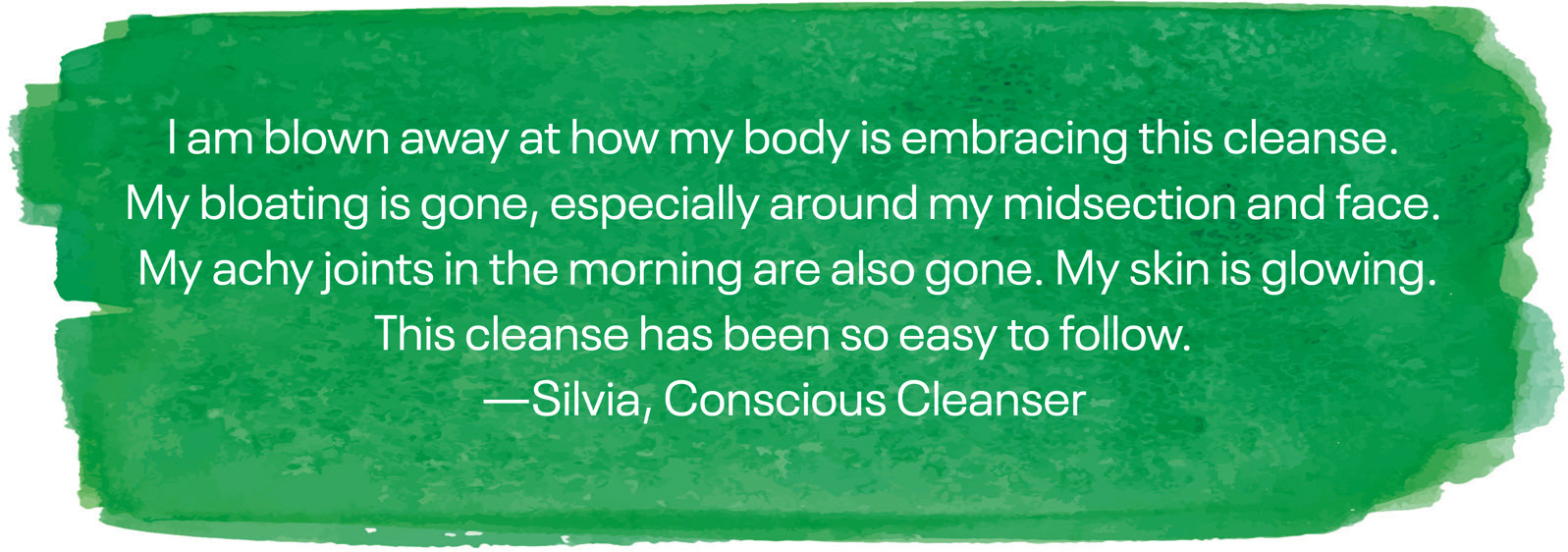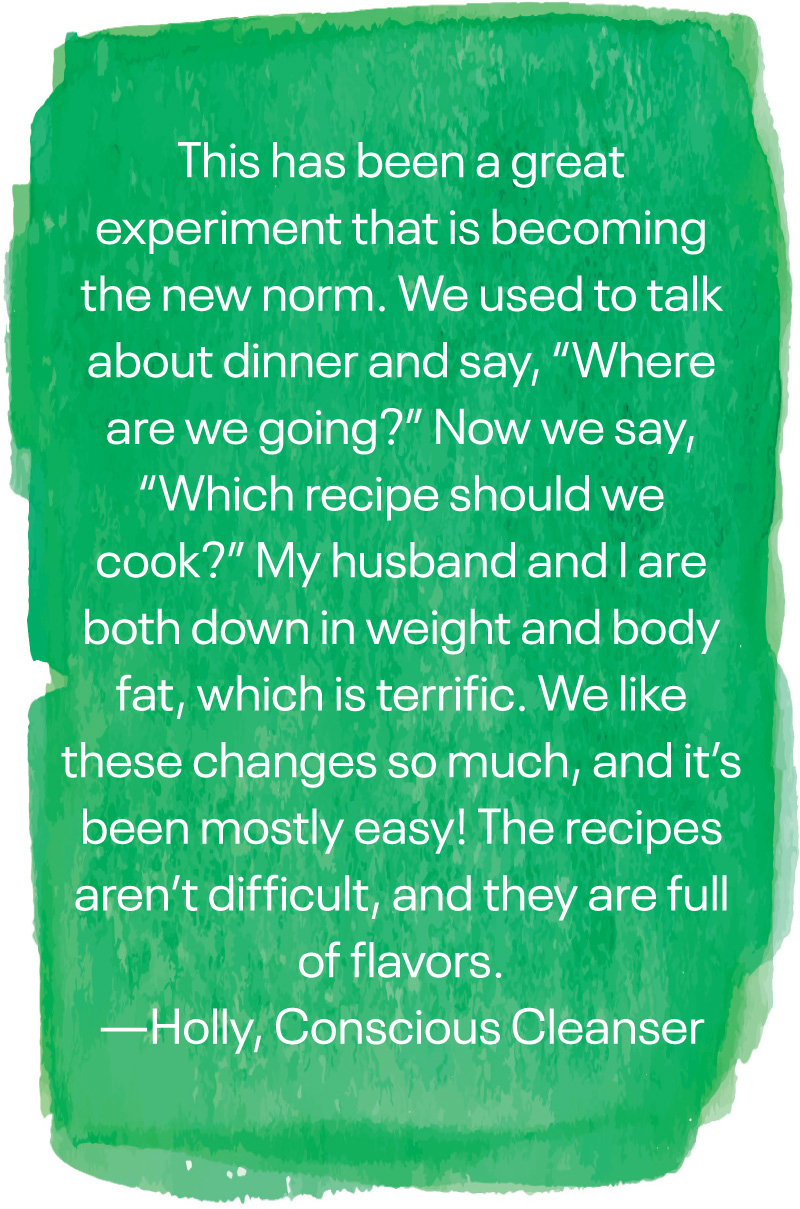conscious cleanse guidelines
In a world of mixed dietary messages, fledgling nutrition science, and countless fad diets, it can feel nearly impossible to know what to eat anymore. Among all this chaos is the call to get back to the basics. The Conscious Cleanse answers that call with a return to simplicity. The following is a bird’s-eye view of what to eat on the Conscious Cleanse. Combine these with the Conscious Cleanse mindset, and you’ll be well on your way to reconnecting with the thriving, radiant, vibrant you!
EAT WHOLE FOODS
Whole foods are foods that exist in nature. Start by imagining a food’s origins. Does it come from a living thing? Can you imagine it growing in a field, on a tree or bush, or in the ocean? Whole foods are foods that do not have ingredients—they are the ingredient. Whole foods are unprocessed, contain no hidden ingredients, and typically don’t come in a package or have a label for you to examine. They often exist on the periphery of the grocery store, and they are colorful foods that fill farmers markets. Brown rice is a good example of a whole food, while rice cakes and brown rice pasta are not because they are more processed forms of the original. Whole foods include fresh fruit and vegetables, nongluten grains, legumes and beans, raw nuts and seeds, organic lean meats, and wild-caught fish.
WHOLE FOOD IMPOSTERS
Some processed foods may try to trick you into thinking they’re whole foods, but they’re not.
- Apple chips
- Banana bread
- Deli meat
- Flavored water
- Fruit juice
- Fruit leather
- Plantain chips
- Protein shakes
- Rice cakes
- Rice pasta
- Veggie straws
- Yogurt raisins
- Zucchini bread

ELIMINATE ALLERGENS
The Conscious Cleanse eliminates the most common food allergens. Some of these foods—like tomatoes, oranges, and eggs—may seem counterintuitive at first. But the fact is, it’s estimated that up to 90 percent (stop and let that sink in) of Americans suffer from food intolerances or allergies, and most are undetected. That bears repeating. A whopping 9 out of 10 people may have some form of food intolerance, and most people do not make the link between the food they’re eating and the physical ailments they’re experiencing. If you’ve ever experienced any of the following, it’s highly likely there is a food intolerance at play: bloating, cramps, diarrhea, constipation, headaches, dark circles under the eyes, clogged sinuses, puffiness, aches, pains, the inability to lose weight despite exercise and a “clean” diet, diabetes, high blood pressure, seasonal allergies, depression, or anxiety.
We know that giving up some of your favorite foods is challenging. We also know the rewards are worth it. Stop yourself if you start to get into a battle over a certain food, and remember it’s often the foods we love and crave the most—the foods we’re addicted to—that we benefit taking a break from the most. The good news is that at the end of 14 days, you’ll be given a unique opportunity to do a mini-experiment with yourself, to isolate your favorite foods in a “clean” system, taking note of exactly how each one feels in your body. You’re bound to learn something new about yourself and the food you eat!
FOODS TO KEEP OFF YOUR PLATE
- Alcohol
- Beef
- Caffeine
- Chocolate (cocoa and raw cacao included)
- Corn
- Dairy (cheese, yogurt, milk, whey protein, and butter)
- Eggs
- Grapefruit
- Nightshades (potatoes, tomatoes, eggplant, and peppers)
- Oranges
- Peanuts
- Pork
- Refined seed and vegetable oils (soy oil, sunflower oil, safflower oil, canola oil, corn oil, cottonseed oil)
- Shellfish (clams, crab, mussels, oysters, shrimp)
- Soy products (edamame, miso, tamari, tempeh, and tofu)
- Strawberries
- Sugar
- Wheat and gluten
- Yeast (including yeasted products like brewer’s yeast and kombucha)
SUPPLEMENTS AND MEDICINES
We’re often asked about supplements and medications on the Conscious Cleanse. First and foremost, always check with your medical provider before going off any prescribed medications or supplements. As a general rule of thumb, though, we like to occasionally eliminate all supplements in order to give our bodies a break. This is also a good time to take inventory. Make sure you know exactly what’s in the supplements you’re taking (pull out the magnifying glass and read the label), and re-evaluate whether those supplements still make sense for you. We also highly recommend that you avoid any over-the-counter drugs, such as painkillers or NSAIDs, as the daily use of such medicines has been linked to many dangerous side effects, the least of which is damaging the gastrointestinal tract. Tobacco, cannabis (marijuana), and street drugs are also not on the menu of the Conscious Cleanse.
GO PLANT POWERED
While most diet plans focus on food labels, which identify you as part of some type of “food club,” we like to think that we’re the program for all types of eaters. So, whether you’d call yourself paleo, pescatarian, omnivore, vegetarian, or vegan, all are welcome here. And frankly, we’re less interested in what you call yourself and more interested in how many veggies you can fit on your plate.
Being plant-based is all the rage, but we have a newsflash for you—you don’t have to be vegetarian or vegan to be plant-based. And guess what? You can eat meat and be plant-based, which is the best way to incorporate animal protein into your diet anyway. So, forget the food labels, and go plant powered with us! As far as how you eat your veggies, the sky’s the limit, and this is where it gets fun! We love coming up with new ways to incorporate veggies into dishes and meals where you may not expect them. For example, a simple green smoothie can deliver an additional 2 cups of dark leafy greens with breakfast! Compare that to a typical breakfast, like a bagel with cream cheese, and you’ve got a massive breakfast makeover, one that’s filled with bioavailable ingredients, alkaline-rich dark leafy greens, and an array of other nutrients and superfoods. This is just one way to add in more veggies, which can have a profound impact on your overall health.
We often recommend eating raw and living foods as much as possible because raw veggies have all their enzymes intact. Think of enzymes like the spark plugs of the body. Every single action in the body involves an enzymatic reaction, from blinking your eyes and wiggling your toes to digesting your food. Digestive enzymes help the body break down and assimilate the food you eat. So, the more enzymes you have, the better you’re going to feel!
All that being said, there are some veggies, particularly cruciferous veggies like broccoli, cauliflower, and cabbage, that don’t always sit well, gastrically speaking. If you find that you get a tummy ache, gas, or bloating after eating certain raw veggies, go ahead and cook them. We love our vegetables lightly steamed, sautéed, grilled, and/or roasted—all depending on the season and our mood. This is again where you can practice tuning in and asking yourself, “Will this food (and the way I prepare it) help me feel more vibrant?”
Finally, if you ever experience any constipation or diarrhea, cooking your veggies can be very helpful. These symptoms can be a sign of inflammation in the gut, perhaps from eating foods you’re allergic to. Cooking your veggies may feel more soothing to your system as you clean it up and heal your gut.
HEAL THE GUT, HEAL THE BODY
Would it surprise you to learn that an unbalanced microbiome is the root cause of most chronic and degenerative illnesses? It’s true! But taking a probiotic supplement is just part of the story. Supplementing your diet with foods rich in healthy probiotics, like our Vegan Kimchi, is key. You also want to eat good sources of prebiotics. Foods like artichokes, asparagus, bananas, chickpeas, dandelion greens, garlic, and onions actually feed beneficial bacteria in your gut. Eat a wide variety of different types of veggies, and not only will you be getting all the right nutrients, you’ll also help balance the good and bad bugs in your gut.

EAT CLEAN FOODS
We’ve already defined whole foods as foods that exist in nature and have not been altered from their original state. Unfortunately, eating “clean” is not as easy or simple as choosing between broccoli and Cheez-Its. As with anything, shades of gray flank the black and white, so it’s worth taking a closer look.
Clean foods are package-free foods. Many of our kitchen staples can be found in the bulk section of your local grocery or health food store—things like nongluten grains, beans, raw nuts and seeds, even spices, dried herbs, and dried fruit. The other mainstay of our eating plan is, as we’ve mentioned, fresh fruits and vegetables—again, no special or fancy packaging is necessary.
Where we often run into trouble with clean eating is with store-bought products that are mired in labels touting eye-catching marketing claims; gluten-free, soy-free, dairy-free, and non-GMO. It must be clean, right? We’ve found the worst culprits to be the dips, dressings, sauces, condiments, and nut milks—products that are supposed to make our clean eating journey easier. Sadly, we can’t tell you how many times we’ve fallen into the trap of thinking a product is clean and “safe,” only to bust out the magnifying glass and learn that sugar is the second ingredient. If you’re going to buy a packaged food, be a label detective. Focus on the list of ingredients in the food. A couple general rules of thumb are: the fewer the ingredients, the better, and if you can’t pronounce it or have to ask someone what it is or does, skip it.
MAKE YOUR OWN STAPLES
The good news is that the cookbook you’re holding in your hands is full of our favorite food makeovers, like Egg-Free Avocado Mayo or Chocolate Dessert Hummus. These recipes were inspired by products we found in the store with ingredients that didn’t match up to our standards. Other great examples are our Homemade Plant-Based Milks. In fact, we only make our own oat milk because there is currently no gluten-free, organic option on the market. Once you learn how simple (and cost effective) it is to make some of your own staples, you’ll never go back to premade ones.
DITCH PLASTICS
We’ve all heard about the harmful effects of bisphenol A (BPA), a chemical in plastics, on the human body, but once BPA-free products began hitting the grocery store shelves, many people let out a sigh of relief thinking that was the end of it. Sadly, that’s not the case, and we are learning that we’re inadvertently eating up to a credit card’s worth of microplastics each week! Luckily, there are many things you can do to minimize consuming plastic. In addition to storing your food in glass containers whenever possible, not buying produce in plastic can make a huge difference. We know it’s convenient to buy the tub of spinach or big bag of romaine lettuce, but avoiding these will help you reduce your plastic consumption while also helping the environment.
